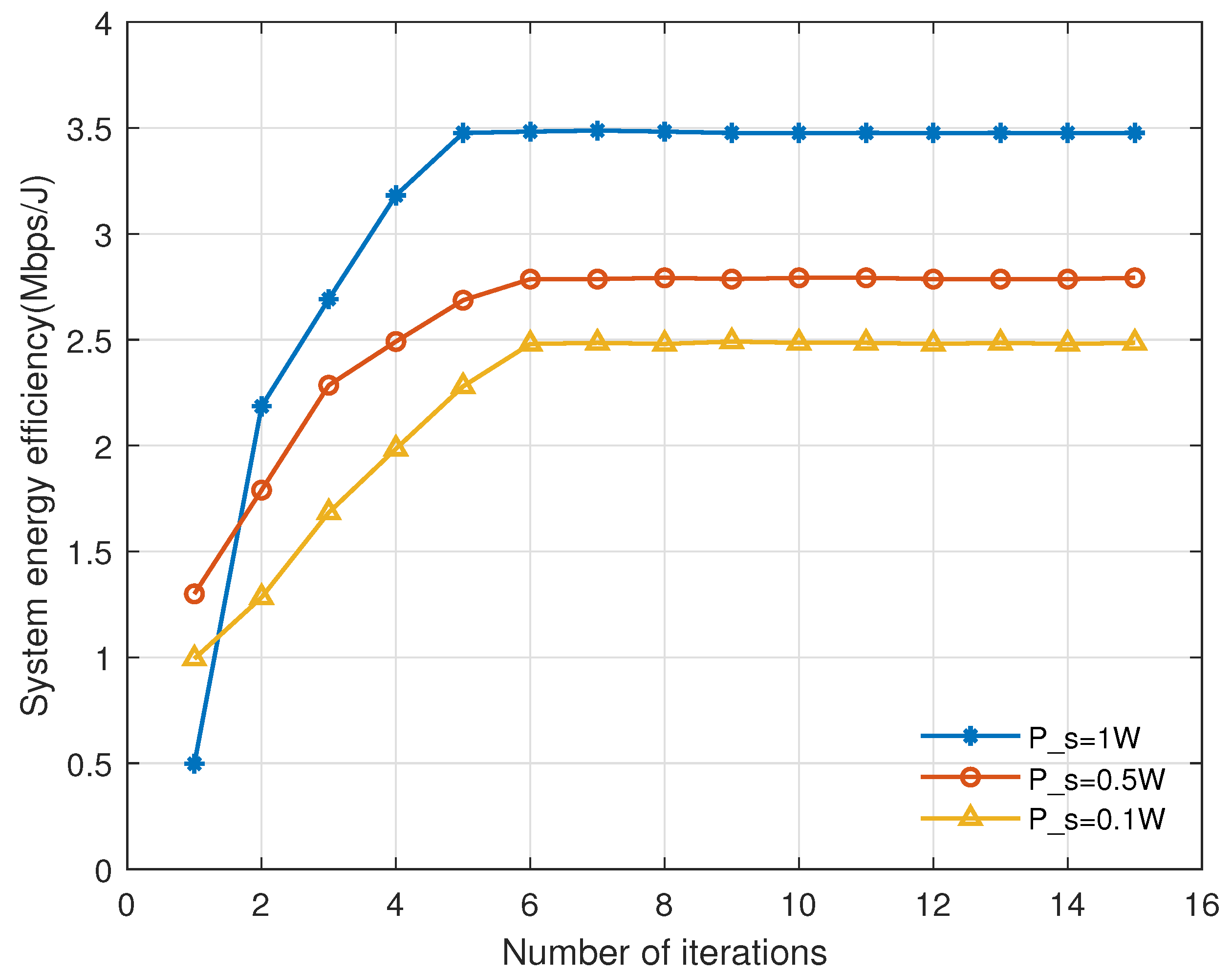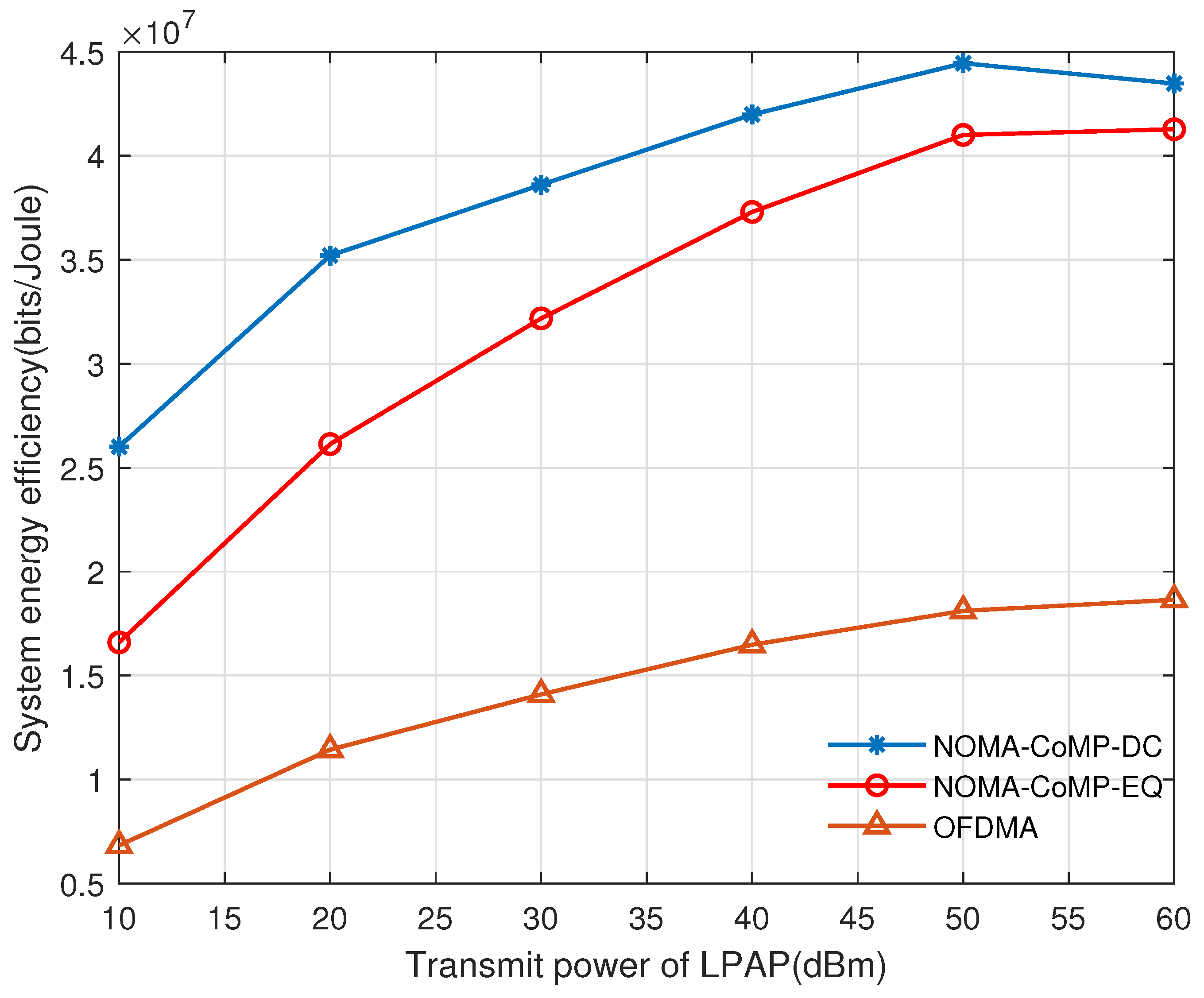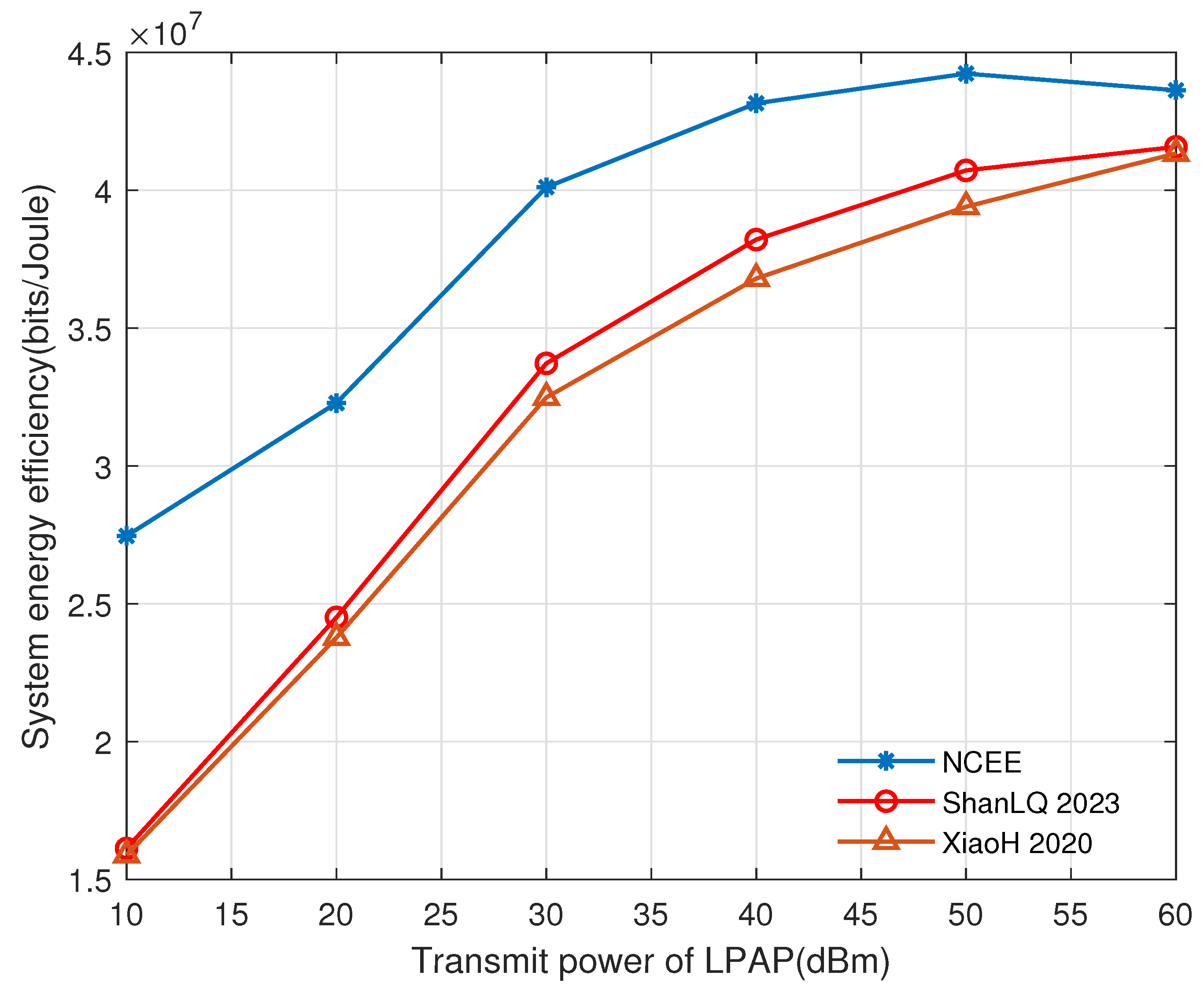Energy Efficiency Optimization for a V2X Network with NOMA-CoMP Enabled
Abstract
:1. Introduction
1.1. Related Work
1.2. Motivation and Contributions
- Taking advantage of the high-density deployment of service nodes, a user-centric V2X network model is constructed, where one mobile vehicle is in the overlapping coverage of multiple access points (APs). To facilitate vehicle scheduling and increase the mobile vehicles’ throughput performance in the proposed network, a collaborative multipoint (CoMP) transmission method is adopted to enable a mobile vehicle to be served by multiple APs simultaneously.
- Aiming at improving the EE performance in the proposed network, an energy-efficient resource optimization problem is formulated. To solve this optimization problem, a NOMA-CoMP–based energy-efficient resource allocation scheme is proposed. In the proposed scheme, a semi-dynamic CoMP APs clustering algorithm is designed to select multiple CoMP APs to serve a vehicle according to the vehicle-AP link channel coefficient and the vehicle’s achievable energy efficiency.
2. System Model
The desired signal of the non-CoMP can be expressed as
3. Problem Optimization and Algorithm Design
3.1. CRNN-Based User Scheduling Scheme
3.1.1. Semi-Dynamic CoMP LPAP Clustering Algorithm
3.1.2. Energy-Efficient NOMA Pair Scheduling Algorithm
| Algorithm 1 Semi-dynamic CoMP LPAP clustering algorithm |
|
| Algorithm 2 Energy-efficient bilateral selection NOMA scheduling algorithm |
|
3.2. Power Allocation Algorithm
| Algorithm 3 DC programming-based power allocation algorithm |
|
4. Numerical Results
5. Conclusions
Author Contributions
Funding
Institutional Review Board Statement
Informed Consent Statement
Data Availability Statement
Conflicts of Interest
References
- You, X.; Wang, C.X.; Huang, J.; Gao, X.; Zhang, Z.; Wang, M.; Huang, Y.; Zhang, C.; Jiang, Y.; Wang, J. Towards 6G wireless communication networks: Vision, enabling technologies, and new paradigm shifts. Sci. China Inf. Sci. 2021, 64, 110301. [Google Scholar] [CrossRef]
- Aljeri, N.; Boukerche, A. Smart and Green Mobility Management for 5G-enabled Vehicular Networks. Trans. Emerg. Telecommun. Technol. 2020, 33, 1–18. [Google Scholar] [CrossRef]
- Guo, C.; Liang, L.; Li, G.Y. Resource Allocation for Low-Latency Vehicular Communications: An Effective Capacity Perspective. IEEE J. Sel. Areas Commun. 2019, 37, 905–917. [Google Scholar] [CrossRef]
- Duan, W.; Gu, J.; Wen, M.; Wen, M.; Zhang, G.; Ji, Y.; Mumtaz, S. Emerging Technologies for 5G-IoV Networks: Applications, Trends and Opportunities. IEEE Netw. 2020, 34, 283–289. [Google Scholar] [CrossRef]
- Shan, L.; Wang, M.M.; Zhang, F.; Chen, S.; Zhang, J. Resource allocation for cellular device-to-device-aided vehicle-to-everything networks with partial channel state information. Trans. Emerg. Telecommun. Technol. 2022, 33, 7. [Google Scholar] [CrossRef]
- Aslani, R.; Saberinia, E.; Rasti, M. Resource allocation for cellular V2X networks mode-3 with underlay approach in LTE-V standard. IEEE Trans. Veh. Technol. 2020, 69, 8601–8612. [Google Scholar] [CrossRef]
- Noor-A-Rahim, M.; Liu, Z.; Lee, H.; Lee, H.; Khyam, M.O.; He, J.; Pesch, D.; Moessner, K.; Saad, W.; Poor, H. 6G for vechicle-to-everthing (V2X) communications: Enabling technologies challenges, and opportunities. Proc. IEEE 2022, 110, 721–734. [Google Scholar] [CrossRef]
- Husain, S.; Kunz, A.; Prasad, A.; Pateromichelakis, E.; Samdanis, K. Ultra-High Reliable 5G V2X Communications. IEEE Commun. Stand. Mag. 2019, 3, 46–52. [Google Scholar] [CrossRef]
- Di, B.; Song, L.; Li, Y.; Han, Z. V2X Meets NOMA:Non-Orthogonal Multiple Access for 5G Enabled Vehicular Networks. IEEE Wirel. Commun. 2017, 24, 14–21. [Google Scholar] [CrossRef]
- Tanwar, S.; Tyagi, S.; Budhiraja, I.; Kumar, N. Tactile internet for autonomous vehicles: Latency and reliability analysis. IEEE Wirel. Commun. 2019, 26, 66–72. [Google Scholar] [CrossRef]
- Zhang, D.; Liu, Y.W.; Ding, Z.G.; Zhou, Z.; Nallanathan, A.; Sato, T. Performance Analysis of Non-Regenerative Massive-MIMO-NOMA Relay Systems for 5G. IEEE Wirel. Commun. 2017, 65, 4777–4790. [Google Scholar] [CrossRef]
- Chen, Y.; Wang, L.; Ai, Y.; Ai, Y.; Jiao, B.; Nalzo, L. Performance Analysis of NOMA-SM in Vehicle to Vehicle Massive MIMO Channels. IEEE J. Sel. Areas Commun. 2017, 35, 2653–2666. [Google Scholar] [CrossRef]
- Zhang, D.; Liu, Y.; Dai, L.; Bashir, A.K.; Nallanathan, A.; Shim, B. Performance Analysis of FD-NOMA-based Decentralized V2X Systems. IEEE Trans. Commun. 2019, 67, 5024–5039. [Google Scholar] [CrossRef]
- Le, C.B.; Do, D.T.; Zaharis, Z.D.; Mavromoustakis, C.X.; Mastorakis, G.; Markakis, E.K. System Performance Analysis in Cognitive Radio-Aided NOMA Network: An Application to Vehicle-to-Everything Communications. Wirel. Pers. Commun. 2021, 120, 1975–2000. [Google Scholar] [CrossRef]
- Zheng, C.; Feng, D.; Zhang, S.; Zhang, S.; Xia, X.-G. Energy Efficient V2X-Enabled Communications in Cellular Networks. IEEE Trans. Veh. Technol. 2019, 68, 554–564. [Google Scholar] [CrossRef]
- Ihsan, A.; Chen, W.; Zhang, S.Q.; Xu, S. Energy-Efficient NOMA Multicasting System for Beyond 5G Cellular V2X Communications With Imperfect CSI. IEEE Trans. Intell. Transp. Syst. 2021, 23, 10721–10735. [Google Scholar] [CrossRef]
- Xiao, H.; Zhu, D.; Chronopoulos, A.T. Power Allocation With Energy Efficiency Optimization in Cellular D2D-Based V2X Communication Network. IEEE Trans. Intell. Transp. Syst. 2020, 21, 4947–4957. [Google Scholar] [CrossRef]
- Jameel, F.; Khan, W.U.; Kumar., N.; Jantti, R. Efficient Power-Splitting and Resource Allocation for Cellular V2X Communications. IEEE Trans. Intell. Transp. Syst. 2021, 21, 3547–3556. [Google Scholar] [CrossRef]
- Shan, L.Q.; Gao, S.T.; Chen, S.S.; Xu, M.; Zhang, F.; Bao, X.; Chen, M. Energy-efficient resource allocation in NOMA-integrated V2X networks. Comput. Commun. 2023, 197, 23–33. [Google Scholar] [CrossRef]
- Xiao, H.; Zhang, X.; Chronopoulos, A.T.; Zhang, Z.; Liu, H.; Ouyang, S. Resource Management for Multi-User-Centric V2X Communication in Dynamic Virtual-Cell-Based Ultra-Dense Networks. IEEE Trans. Commun. 2020, 68, 6346–6358. [Google Scholar] [CrossRef]
- Gao, W.; Wu, C.; Zhong, L.; Yau, K.L.A. Communication Resources Management Based on Spectrum Sensing for Vehicle Platooning. IEEE Trans. Intell. Transp. Syst. 2023, 24, 2251–2264. [Google Scholar] [CrossRef]
- Zhou, Y.; Zhang, Y. User-centric data communication service strategy for 5G vehicular networks. IET Commun. 2021, 16, 1041–1056. [Google Scholar] [CrossRef]
- Sun, W.; Liu, J. 2-to-M coordinated multipoint-based uplink transmission in ultra-dense cellular networks. IEEE Trans. Wirel. Commun. 2018, 17, 8342–8356. [Google Scholar] [CrossRef]
- Pan, C.H.; Elkashlan, M.; Wang, J.Z.; Yuan, J.; Hanzo, L. User-centric C-RAN architecture for ultra-dense 5G networks:Challenges and methodologies. IEEE Commun. Mag. 2018, 56, 14–20. [Google Scholar] [CrossRef]
- Vucic, N.; Shi, S.; Schubert, M. DC programming approach for resource allocation in wireless networks. In Proceedings of the 8th International Symposium on Modeling and Optimization in Mobile, Ad Hoc, and Wireless Networks, Avignon, France, 31 May–4 June 2010; pp. 380–386. [Google Scholar]
- Boyd, S.; Vandenberghe, L. Convex Optimization; Cambridge University Press: Cambridge, UK, 2004. [Google Scholar]
- Nemirovskii, B.-T. Lectures on Modern Convex Optimization; Society for Industrial and Applied Mathematics: Cambridge, MA, USA, 2001. [Google Scholar]
- Tech University. 3rd Generation Partnership Project; Technical Specification Group Radio Access Network; Study on LTE Based V2X Services; (Release 14) 3GPP; Tech: Ruston, LO, USA, 2016. [Google Scholar]






| Parameter | Value |
|---|---|
| Carrier frequency | 2 GHz |
| System bandwidth | 5 MHz |
| Maximum power of LPAP | 41 dBm |
| Noise power | −114 dBm |
| Number of LPAPs | 20 |
| Max number of vehicles | 60 |
| Minimum distance between small base station and vehicle | 25 m |
| Minimum distance between vehicles | 40 m |
| Vehicle speed | km/h |
| HPAP cell radius | 500 m |
| LPAP cell radius | 200 m |
| Parameter | Value Communication Link between Vehicle and LPAP |
|---|---|
| Path loss model | d in km |
| Shadow distribution | Log–normal |
| Shadow distribution standard deviation | 8 dB |
| Fast fading | Rayleigh fading |
Disclaimer/Publisher’s Note: The statements, opinions and data contained in all publications are solely those of the individual author(s) and contributor(s) and not of MDPI and/or the editor(s). MDPI and/or the editor(s) disclaim responsibility for any injury to people or property resulting from any ideas, methods, instructions or products referred to in the content. |
© 2023 by the authors. Licensee MDPI, Basel, Switzerland. This article is an open access article distributed under the terms and conditions of the Creative Commons Attribution (CC BY) license (https://creativecommons.org/licenses/by/4.0/).
Share and Cite
Xu, W.; Tian, J. Energy Efficiency Optimization for a V2X Network with NOMA-CoMP Enabled. Electronics 2023, 12, 4590. https://doi.org/10.3390/electronics12224590
Xu W, Tian J. Energy Efficiency Optimization for a V2X Network with NOMA-CoMP Enabled. Electronics. 2023; 12(22):4590. https://doi.org/10.3390/electronics12224590
Chicago/Turabian StyleXu, Woping, and Junhui Tian. 2023. "Energy Efficiency Optimization for a V2X Network with NOMA-CoMP Enabled" Electronics 12, no. 22: 4590. https://doi.org/10.3390/electronics12224590
APA StyleXu, W., & Tian, J. (2023). Energy Efficiency Optimization for a V2X Network with NOMA-CoMP Enabled. Electronics, 12(22), 4590. https://doi.org/10.3390/electronics12224590





